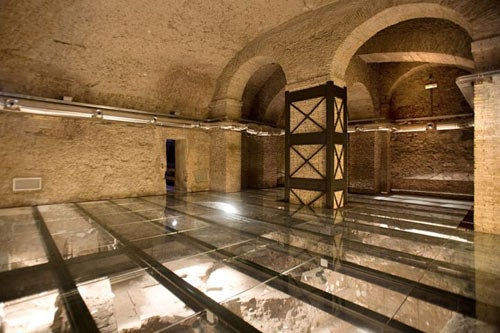City Breaks: Who lived in a house like this? Use your imagination
Exploring the newly excavated ruins of the Palazzo Valentini in Rome is a thoroughly 21st-century affair, says Claudia Pritchard

Your support helps us to tell the story
From reproductive rights to climate change to Big Tech, The Independent is on the ground when the story is developing. Whether it's investigating the financials of Elon Musk's pro-Trump PAC or producing our latest documentary, 'The A Word', which shines a light on the American women fighting for reproductive rights, we know how important it is to parse out the facts from the messaging.
At such a critical moment in US history, we need reporters on the ground. Your donation allows us to keep sending journalists to speak to both sides of the story.
The Independent is trusted by Americans across the entire political spectrum. And unlike many other quality news outlets, we choose not to lock Americans out of our reporting and analysis with paywalls. We believe quality journalism should be available to everyone, paid for by those who can afford it.
Your support makes all the difference.Walking on glass, above a void, is an uncertain occupation. No matter that the thick plate is designed to take the weight of many, you veer towards the walls between which the glacial floor is suspended.
The exploration of classical ruins is normally a ground-based affair. Generations of travellers to Rome have trudged in stout shoes and alarming sandals between the foundations of buildings long tumbled down, visualising the hypercaust, the hot bath, and, to the delight of children, the communal toilets. Amid the ruins we point into thin air and declare that here the Ancient Romans legislated, lounged and loofahed.
But the science journalist and historian Piero Angela has recently shoved Rome into the 21st century, creating what in Britain would be called an "experience". And that is why, instead of stumbling between antique stones, 20 visitors to the newly excavated Palazzo Valentini, mostly grave and graceful middle-aged Italians, are shuffling above them, on the glass floor.
Palazzo Valentini has that many-layered history that characterises a substantial edifice in the heart of the city. But pick away at the seams of building stone, paving slabs, household refuse, road and charred ruins, and 1,500 years down, you hit upon two substantial villas, judged by their scale and lavishness of ornament to have been the vast homes of senators. On the way down you pass the age of Handel: he was a guest when the palace, built by the cardinal nephew of Pope Pius V, was let to the princes of the Ruspoli family. Then come the fifth- and sixth-century villas, opened a few weeks ago after three years of excavation.
Compared with the expanses of the Imperial Forum a few yards away, this site is modest in scale – a handful of floor plans, viewed from above. Then, suddenly, the rooms expand: the crumbling walls are restored to their original splendour, clad with panels of marble, trimmed in deepest red. Broken mosaics are completed before our eyes; luscious russets and ochre wash over the walls of the grand staircase – grander than any other known, even at Pompeii. Delicate motifs restore charm and calm to the bedrooms. It's all done with computers, of course, sound and light projections hovering over the ruins.
First comes a reception room, marble lined, with statuary in the niches. Next, the red-walled stairway. Because most domestic archaeology stops at knee height, we are apt to forget that, like us, the ancients pushed on up to the eaves, building high for more space, better views.
Who would live in a house like this? Here come the faces of likely inhabitants – firm-browed patricians with set mouths and their ringletted wives. And what in the world were they doing? Conquering it, for the most part. For now emerges a virtual globe and, zoom, zoom, the Roman Empire spreads wider by the second – first Italy, now the rest of Europe, Iraq, Libya, Algeria. Africa is such a useful source of coloured marble and of amphorae, too, like those discarded in the rubbish pit that the adjacent baths are to become.
Then we dive from the heavens, back into the heart of Rome and into this important house's most imposing room, marble-clad and softened with sumptuous cushions, somewhere to curl up with a scroll reached down from the hundreds stacked into wall recesses. From this virtual room we speed through the kitchens, the stores, the scullery, the stables. Watch those torches so close to that hay! There is evidence at Palazzo Valentini of a catastrophic fire, but marauding barbarians are probably to blame.
In the second villa the marvel is the mosaic work in two rooms that probably led on to an internal courtyard. Virtual rain falls on the black and white tesserae, but there is shelter in a virtual loggia, as out of a single base sprouts first one column and then, alongside, a dozen more.
"It's as good as a GameBoy," one of the first young visitors had proclaimed, and certainly there is a place for this mix of solid research and computer graphics. As for the noodling mood music – well, Handel it is not. But let's not be churlish. The whole thing is free: you simply have to book.
COMPACT FACTS
How to get there
Claudia Pritchard flew to Rome with Alitalia (08714 24 14 24; alitalia.com), which has five daily flights from Heathrow to Rome from £112 return. She was a guest of the Hotel Romae (00 39 0644 63554; hotelromae. com), where double rooms cost from £40 per night.
Further information
Palazzo Valentini (0039 06 6766 7324; provincia.roma.it) is open daily except public holidays. Free guided tours in English are at 1.30pm on Tuesday and Thursday.
Join our commenting forum
Join thought-provoking conversations, follow other Independent readers and see their replies
Comments